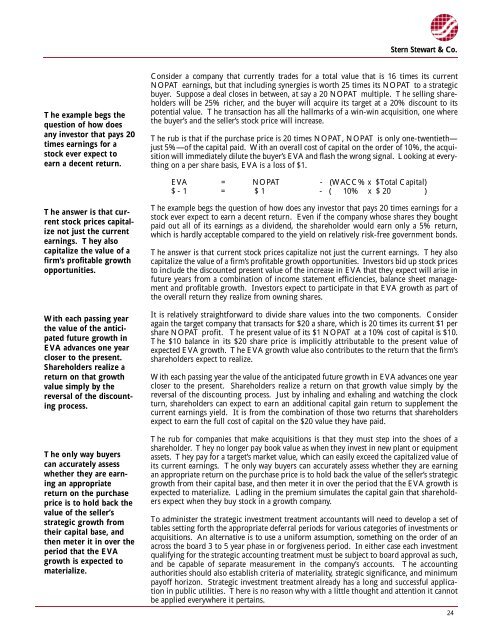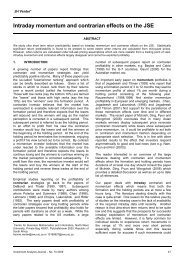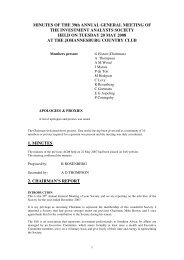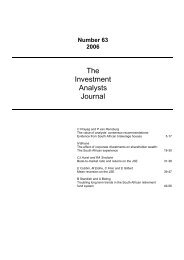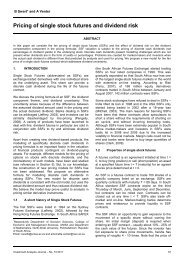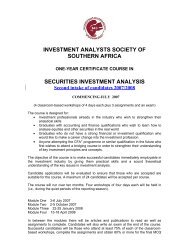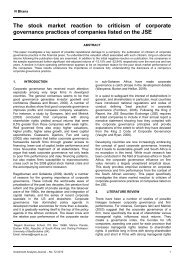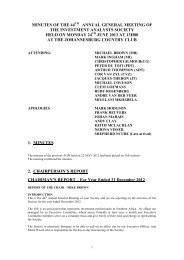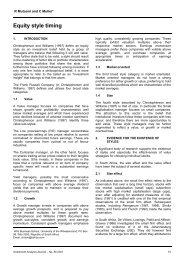Accounting is Broken - Investment Analysts Journal
Accounting is Broken - Investment Analysts Journal
Accounting is Broken - Investment Analysts Journal
You also want an ePaper? Increase the reach of your titles
YUMPU automatically turns print PDFs into web optimized ePapers that Google loves.
Stern Stewart & Co.<br />
The example begs the<br />
question of how does<br />
any investor that pays 20<br />
times earnings for a<br />
stock ever expect to<br />
e a rn a decent re t u rn .<br />
Consider a company that currently trades for a total value that <strong>is</strong> 16 times its curre n t<br />
N O PAT earnings, but that including synergies <strong>is</strong> worth 25 times its NOPAT to a strategic<br />
b u y e r. Suppose a deal closes in between, at say a 20 NOPAT multiple. The selling shareholders<br />
will be 25% richer, and the buyer will acquire its target at a 20% d<strong>is</strong>count to its<br />
potential value. The transaction has all the hallmarks of a win-win acqu<strong>is</strong>ition, one where<br />
the buyer’s and the seller’s stock price will incre a s e .<br />
The rub <strong>is</strong> that if the purchase price <strong>is</strong> 20 times NOPAT, NOPAT <strong>is</strong> only one-twentieth—<br />
just 5%—of the capital paid. With an overall cost of capital on the order of 10%, the acqu<strong>is</strong>ition<br />
will immediately dilute the buyer’s EVA and flash the wrong signal. Looking at everything<br />
on a per share bas<strong>is</strong>, EVA <strong>is</strong> a loss of $1.<br />
E VA = NOPAT - (WACC% x $Total Capital)<br />
$ - 1 = $ 1 - ( 10% x $ 20 )<br />
The answer <strong>is</strong> that current<br />
stock prices capitalize<br />
not just the curre n t<br />
e a rnings. They also<br />
capitalize the value of a<br />
f i rm ’s profitable gro w t h<br />
o p p o rt u n i t i e s .<br />
With each passing year<br />
the value of the anticipated<br />
future growth in<br />
E VA advances one year<br />
closer to the pre s e n t .<br />
S h a reholders realize a<br />
re t u rn on that gro w t h<br />
value simply by the<br />
reversal of the d<strong>is</strong>counting<br />
pro c e s s .<br />
The only way buyers<br />
can accurately assess<br />
whether they are earning<br />
an appro p r i a t e<br />
re t u rn on the purc h a s e<br />
price <strong>is</strong> to hold back the<br />
value of the seller’s<br />
strategic growth fro m<br />
their capital base, and<br />
then meter it in over the<br />
period that the EVA<br />
g rowth <strong>is</strong> expected to<br />
m a t e r i a l i z e .<br />
The example begs the question of how does any investor that pays 20 times earnings for a<br />
stock ever expect to earn a decent re t u rn. Even if the company whose shares they bought<br />
paid out all of its earnings as a dividend, the shareholder would earn only a 5% re t u rn ,<br />
which <strong>is</strong> hardly acceptable compared to the yield on relatively r<strong>is</strong>k-free government bonds.<br />
The answer <strong>is</strong> that current stock prices capitalize not just the current earnings. They also<br />
capitalize the value of a firm ’s profitable growth opportunities. Investors bid up stock prices<br />
to include the d<strong>is</strong>counted present value of the increase in EVA that they expect will ar<strong>is</strong>e in<br />
f u t u re years from a combination of income statement efficiencies, balance sheet management<br />
and profitable growth. Investors expect to participate in that EVA growth as part of<br />
the overall re t u rn they realize from owning share s .<br />
It <strong>is</strong> relatively straightforw a rd to divide share values into the two components. Consider<br />
again the target company that transacts for $20 a share, which <strong>is</strong> 20 times its current $1 per<br />
s h a re NOPAT profit. The present value of its $1 NOPAT at a 10% cost of capital <strong>is</strong> $10.<br />
The $10 balance in its $20 share price <strong>is</strong> implicitly attributable to the present value of<br />
expected EVA growth. The EVA growth value also contributes to the re t u rn that the firm ’s<br />
s h a reholders expect to re a l i z e .<br />
With each passing year the value of the anticipated future growth in EVA advances one year<br />
closer to the present. Shareholders realize a re t u rn on that growth value simply by the<br />
reversal of the d<strong>is</strong>counting process. Just by inhaling and exhaling and watching the clock<br />
t u rn, shareholders can expect to earn an additional capital gain re t u rn to supplement the<br />
c u rrent earnings yield. It <strong>is</strong> from the combination of those two re t u rns that share h o l d e r s<br />
expect to earn the full cost of capital on the $20 value they have paid.<br />
The rub for companies that make acqu<strong>is</strong>itions <strong>is</strong> that they must step into the shoes of a<br />
s h a re h o l d e r. They no longer pay book value as when they invest in new plant or equipment<br />
assets. They pay for a targ e t ’s market value, which can easily exceed the capitalized value of<br />
its current earnings. The only way buyers can accurately assess whether they are earn i n g<br />
an appropriate re t u rn on the purchase price <strong>is</strong> to hold back the value of the seller’s strategic<br />
g rowth from their capital base, and then meter it in over the period that the EVA growth <strong>is</strong><br />
expected to materialize. Ladling in the premium simulates the capital gain that share h o l d-<br />
ers expect when they buy stock in a growth company.<br />
To admin<strong>is</strong>ter the strategic investment treatment accountants will need to develop a set of<br />
tables setting forth the appropriate deferral periods for various categories of investments or<br />
acqu<strong>is</strong>itions. An alternative <strong>is</strong> to use a uniform assumption, something on the order of an<br />
a c ross the board 3 to 5 year phase in or forgiveness period. In either case each investment<br />
qualifying for the strategic accounting treatment must be subject to board approval as such,<br />
and be capable of separate measurement in the company’s accounts. The accounting<br />
authorities should also establ<strong>is</strong>h criteria of materiality, strategic significance, and minimum<br />
p a y o ff horizon. Strategic investment treatment already has a long and successful application<br />
in public utilities. There <strong>is</strong> no reason why with a little thought and attention it cannot<br />
be applied every w h e re it pert a i n s .<br />
24


